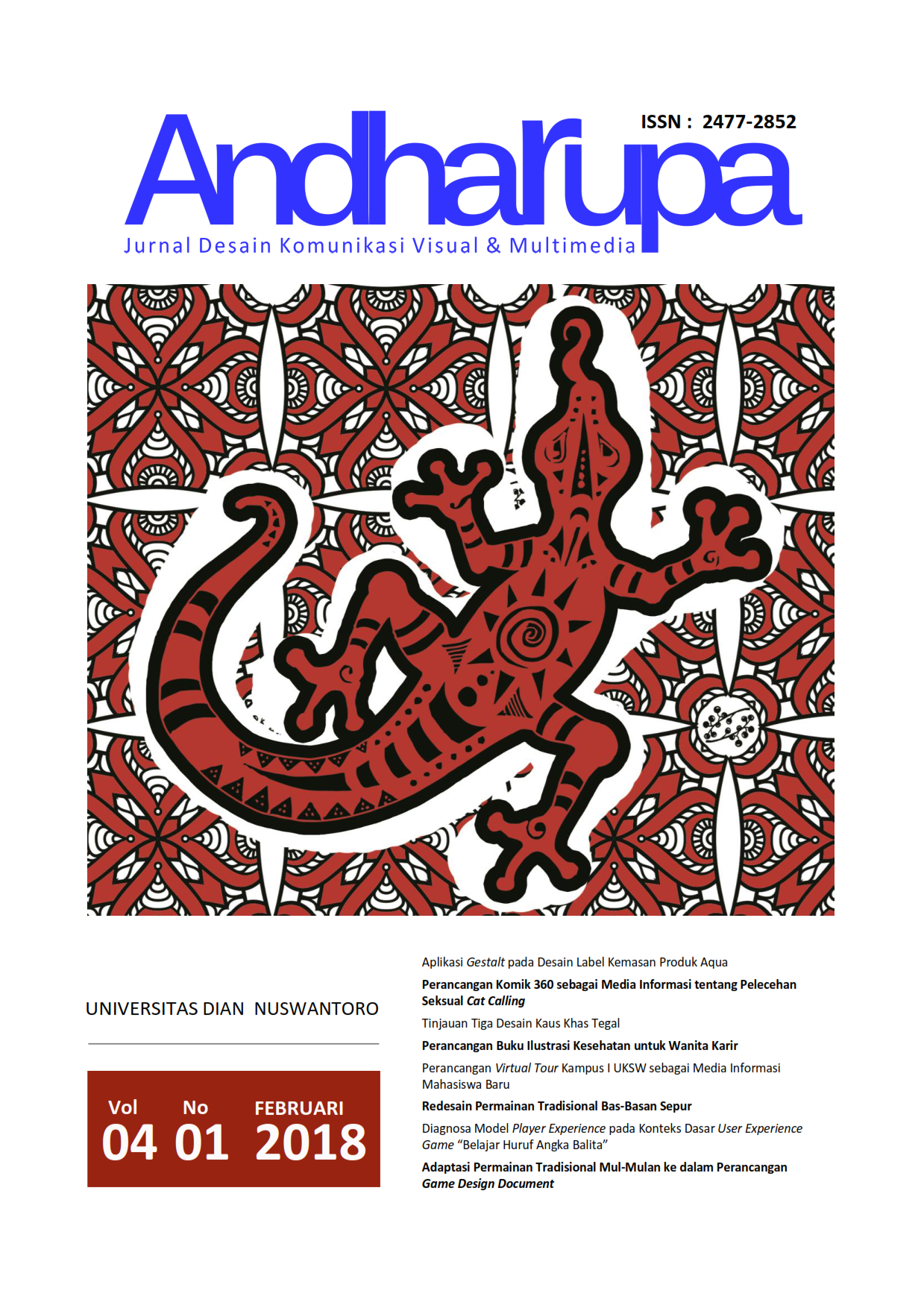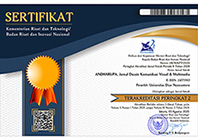Redesain Permainan Tradisional Bas-Basan Sepur
DOI:
https://doi.org/10.33633/andharupa.v4i01.1325Abstract
Abstrak Indonesia adalah negeri yang kaya akan nilai-nilai budaya dan tradisi. Kekayaan ini sudah seharusnya menjadi sumber inspirasi untuk beragam karya kreatif masa kini. Banyak hal yang dapat dikaji dan dikemas kembali dengan lebih baik untuk menjadi sebuah produk di bidang industri kreatif. Salah satu potensi tersebut adalah permainan tradisional. Melalui proses simulasi berulang untuk memahami karakter permainan, lalu mengkombinasikanya dengan kebutuhan pasar board game yang relevan, diharapkan dapat menemukan sebuah bentuk transformasi yang sesuai dengan perkembangan zaman sebagai bagian dari produk industri kreatif. Penelitian ini bertujuan untuk menemukan pakem dari sebuah permainan tradisional dan unsur terkait yang membentuk permainan tersebut, sehingga dalam proses pengembangan dalam konteks redesain, permainan hasil proses redesain akan tetap memiliki karakter serta nilai yang sama dari permainan aslinya namun masih relevan dengan kebutuhan pasar di jaman ini. Kata Kunci: permainan tradisional, transformasi budaya, redesain AbstractIndonesia is a country rich in cultural values and traditions. This wealth should be a source of inspiration for a variety of creative works today. Much can be reviewed and repacked better to become a product in the field of creative industry. One such potential is the traditional game. Through a recurring simulation process to understand the character of the game, then combine it with the relevant board game market needs, it is expected to find a form of transformation that fits the times as part of the creative industry product. This study aims to find the grip of a traditional game and related elements that make up the game, so that in the development process in the redesign context, the redesigned game will still have the same character and value of the original game, but still relevant with now day’s market needs. Keywords: traditional games, cultural transformation, redesignReferences
Browan, Tim dan Jocelyn Wyatt. (2010). Design thinking for social innovation. Stanford Social Innovation Review Winter. STANFORD. Graduate School of Business.
Khamadi, K., & Senoprabowo, A. (2016). Model Adaptasi Permainan Papan Tradisional Macanan Ke Dalam Perancangan Permainan Digital. ANDHARUPA, 2(2), 167–180.
Khamadi, K., Sihombing, R. M., & Ahmad, H. A. (2015). Perancangan Konsep Adaptasi Permainan Tradisional Bas-Basan Sepur dalam Permainan Digital “Amukti Palapa.†Jurnal Komunikasi Visual WIMBA, 5(2).
Lin, R., Chen. C.T. (2012). A discourse on the construction of a service innovation model: focus on the cultural and creative industry park. In: Ifinedo, P. (ed.) EBUSINESS-Application and Global Acceptance, pp. 119-136. Croatia, InTech
Lin, R., Hsieh, H.-Y., Sun, M.-X., Gao, Y.-J. (2016). From Ideality to Reality- a case study of mondarian style. In: Rau, P.-L.P. CCD2016 LNCS, pp. 365-376, Switzerland
Misbah, I.H. (2007). Peran Permainan Tradisional Yang Bermuatan Edukatif Dalam Menyumbang Pembentukan dan Identitas Bangsa. Bandung: IPI.
Nugraha, A. (2012). Transforming Tradition: A Method for Maintaining Tradition in a Craft and Design Context. Helsinki: Aalto University, School of Arts, Design and Architecture, Finland.
Pica, Rae. (2012). Permainan-Permainan Pengembang Karakter Anak-Anak. Jakarta: PT. Indeks
Ralibi, Raymond, Achmad Syarief, dan Irfansyah. (2016). Perancangan mobile game berdasarkan permainan tradisional rakyat “Dodombaan†untuk membangun interaksi sosial antar pemain, Serat Rupa Journal of Design,Vol.1, No.2:289-300.
Downloads
Published
Issue
Section
License
Copyright (c) 2018 ANDHARUPA: Jurnal Desain Komunikasi Visual & Multimedia

This work is licensed under a Creative Commons Attribution 4.0 International License.
Authors who publish with this journal agree to the following terms:
- Authors retain copyright and grant the journal right of first publication with the work simultaneously licensed under a Creative Commons Attribution License that allows others to share the work with an acknowledgment of the work's authorship and initial publication in this journal.
- Authors are able to enter into separate, additional contractual arrangements for the non-exclusive distribution of the journal's published version of the work (e.g., post it to an institutional repository or publish it in a book), with an acknowledgment of its initial publication in this journal.
- Authors are permitted and encouraged to post their work online (e.g., in institutional repositories or on their website) prior to and during the submission process, as it can lead to productive exchanges, as well as earlier and greater citation of published work (See The Effect of Open Access).















